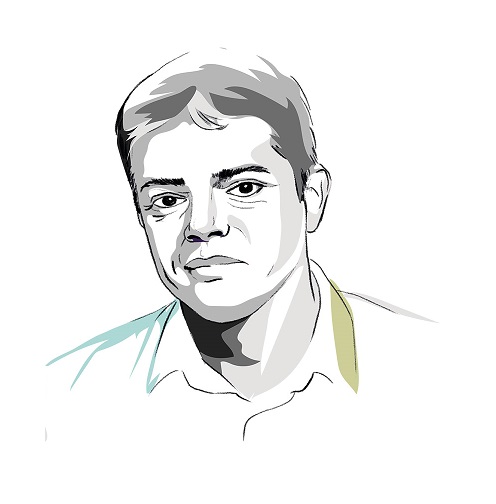Several things need to be done in order to halt the destructive race towards urban expansion: increase urban density on a like-for-like basis, make use of the existing urban environment and develop circular cities. This requires a collective, agile approach. What conditions, constraints and limits will apply to such a far-reaching transformation of our models? The Agility Effect brought together Céline Acharian, CEO of La Fabrique de la Cité, a VINCI think tank, and Sylvain Grisot, urban planner and founder of the firm dixit.net, to discuss these key issues for the environmental transition.
Sylvain Grisot, in 2021 you published Manifeste pour un urbanisme circulaire(1) and more recently Réparons la ville ! with Christine Leconte(2). What is a circular city?
Sylvain Grisot. It promotes a transition from a linear model, where we use new agricultural land increasingly far away from cities to build new shops and houses, to a circular process where we rely on as many loops as possible to optimise each square metre. Once this principle has been established, a circular city can be defined in several ways depending on whether you look at the functions or the fabric of the city.
By functions I mean material and immaterial flows, everything that comes into, goes out of or stays in the city. And by fabric I’m referring in particular to materials (including waste) involved in construction and engineering activities, which we know to be resource-intensive and a major source of CO2 emissions.
However, with urban fabric you also need to understand an immaterial resource – space. Looking at urban metabolism means asking what a city is and what it is not, where it starts and where it ends. Traditional town planning culture tends to analyse the fabric of the city from a land perspective. What I call circular town planning is urban fabric seen through the lens of spatial as well as land flows. There are different interpretations of city-based circularity, but the goal they all seek to achieve is to transform practices and make them go in the right direction.
So a circular city is primarily about curbing urban sprawl?
Céline Acharian. France has one of the highest levels of land take in Europe, with a ratio of 47km² of artificial surfaces for every 100,000 inhabitants. That is twice as high as in Italy. Between 2009 and 2019, 70% of this construction spree was driven by housing. Today we all know that soil is essential in fighting climate change and ensuring food self-sufficiency. The linear approach of saying “I’ve none left, so I’ll take some more” is all the more crazy since we are pre-empting vacant land to develop even as people and their businesses are abandoning entire areas, especially urban ones. Basically, we must increase density on a like-for-like basis, starting from what already exists. Many local stakeholders didn’t wait for the latest Intergovernmental Panel on Climate Change (IPCC) report to take action in this regard.
“Many local stakeholders didn’t wait for the latest IPCC report to take action to promote circular cities.” (Céline Acharian)
Sylvain Grisot. Sprawl isn’t the problem, it’s the symptom. In fact it’s the symptom of a system running perfectly but in the wrong direction. It’s a relatively recent vicious circle that gathered momentum in the 1970s and 1980s. The driving force behind this production and construction system was the boom in private cars, which encouraged urban expansion, the rollout of structures and activities further afield, and car dependency. So we’ve come full circle, ticking all the boxes: soil erosion, biodiversity loss, threat to food security, greater use of carbon-emitting mobility systems, reliance on new construction, and so on. That’s why spatial flows are key to the fabric of a circular city. For as soon as you become more efficient in terms of use of space, you automatically look at how to reuse land, buildings and forms of mobility.
How can the government help to accelerate the implementation of urban circularity?
Céline Acharian. Financial help is available, which can be useful. But I should point out that it is dwindling. What the government should do is show its confidence in initiatives emerging at local level and relax regulatory constraints so as to allow room for experimentation. There are exceptions for research permits in some fields – why not also in the field of town planning?
From a methodological point of view, what approaches should be prioritised?
Sylvain Grisot. The research I’ve undertaken in circular town planning has helped me to identify four loops. The first involves intensifying the use of buildings and focusing more on utilisation time than on space. The second includes reusing existing buildings to avoid demolishing and rebuilding as far as possible. The third seeks to densify available space in urban and peri-urban areas for new build projects. And finally the last loop involves repurposing and restoring the city by assigning new uses to brownfield sites for example.

Is the “no net land take by 2050” objective a step in the right direction?
Céline Acharian. Many elected officials didn’t wait for the target to be set in order to devise solutions, submit them to local stakeholder ecosystems and test them. They took the decision themselves to stop granting planning permission indiscriminately, to prevent local urban planning schemes from stacking up and housing estates from expanding, and started increasing the density of suburban neighbourhoods.
However, the fact that the no net land take objective has been established and that it brings all initiatives together under one banner provides an interesting opportunity to examine practices and reflect more deeply on urban circularity. Today everyone is clinging to the objective as best they can, with their own system of constraints, by developing their own metrics. Of course at some point the calculation scales will need to be aligned and local approaches will need to become consistent on a scale large enough to allow an interaction and multiplier effect. One thing is for sure: the objective has stirred up a hornet’s nest.
“You can see a lot of initiatives being implemented locally, but we need to look at how to accelerate them and how to reach critical mass.” (Sylvain Grisot)
Sylvain Grisot. I agree. Although public policy, including no net land take policy, fails in my opinion to address the cause and consequence of the problem, the effects on the system are there. And you can see a lot of often exemplary initiatives being implemented locally. Having said that, we need to look at how to accelerate them and how to reach critical mass.
What provisions, tools and environments would be likely to facilitate project deployment?
Céline Acharian. What is certain is that local elected officials need to be given free rein. The multiple layers of regulations, the numerous constraints linked to administrative boundaries, the complex standards, the pressure of risk prevention, and civil defence and heritage protection orders form a whole regulatory system, which, even if there are valid reasons behind it, is more discouraging than anything else. This is also the case for issues which are generally agreed to be urgent. The mayor of a small municipality in Greater Paris recently told us that he had had to fight on all fronts to test a water circularity system in his area. The same observation goes for forests and timber: fire regulations, local fire and rescue services, and so on make it very difficult to experiment. In short, the constraints are such that, in areas where agile processes could be put in place, stakeholders often give up.
Who is in a position to drive action? Is the impetus coming from elected officials?
Sylvain Grisot. Let’s be clear, of the 500,000 local elected officials in France 490,000 of them have no control over anything. We must stop thinking in terms of decision-making power. Urban circularity is pre-eminently a collective issue, which must enable us to re-establish ties so that we can reflect, question and experiment together. I believe we must even stop thinking in terms of innovation. It’s not a question of innovating, but of giving things up. The real question is: how do we stop doing the wrong thing? What should we stop doing? We must all face up to our responsibilities.
Céline Acharian. I completely agree with the idea that these are collective, shared issues. However, local elected officials and, more broadly, local stakeholders have an important role to play. I’m not talking so much about responsibility but more about their capacity to act and experiment. An elected official responsible for town planning in Rennes recently said that, amid an overall climate of mistrust among the public regarding the government’s ability to set clear directions, the only real policy area still considered by citizens to be of some use is that of urban policy, specifically housing policy. This is recognition that elected officials have a genuine capacity to act.
(*) Grisot (S.), Manifeste pour un urbanisme circulaire (Manifesto for circular town planning), Editions Apogée, 2021.
(**) Leconte (C.), Grisot (), Réparons la ville ! (Let’s repair our cities!), Editions Apogée, 2022.
14/09/2023




